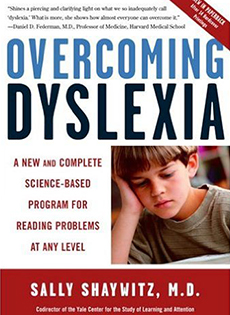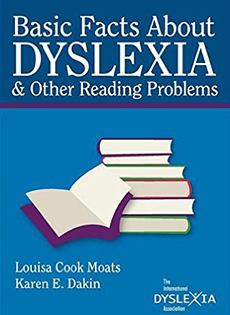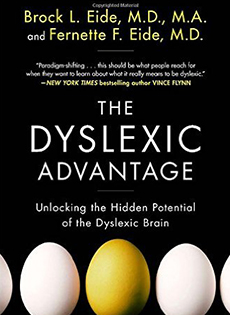What is Dyslexia?
Dyslexia is a specific learning disability that is neurobiological in origin. It is characterized by difficulties with accurate and/or fluent word recognition and by poor spelling and decoding abilities. These difficulties typically result from a deficit in the phonological component of language that is often unexpected in relation to other cognitive abilities and the provision of effective classroom instruction. Secondary consequences may include problems in reading comprehension and reduced reading experience that can impede growth of vocabulary and background knowledge.1
- 15-20% Of the population shows some of the symptoms of dyslexia1
- 1:1 Dyslexia affects comparable numbers of boys and girls2
- 91% Of people have heard of dyslexia3
SIGNS OF DYSLEXIA FOR PRESCHOOLERS
- Difficulty learning letters and corresponding sounds1
- Trouble learning nursery rhymes4
- Seems unable to recognize the letters in his or her own name4
- Mispronounces familiar words4
- Doesn’t recognize rhyming patterns like cat, bat, rat4
SIGNS OF DYSLEXIA FOR kindergarten through fourth grade
- Difficulty reading single words5
- Trouble connecting letters and sounds5
- Confuses small words, for example “at/to” or “said/and”5
- Consistent reading errors including:5
- Letter reversals (“d” for “b”)
- Word reversals (“tip” for “pit”)
- Inversions (“m” for “w”)
- Transpositions (“felt” and “left”)
- Substitutions (“house” and “home”)
- Struggles to remember or understand facts5
signs of dyslexia in older students
- Struggles to organize written and spoken language4
- Trouble memorizing number facts and performing math operations4
- Difficulty with spelling4
- Cannot read quickly enough to comprehend4
- May struggle to learn foreign languages4
What to Do if You Notice Signs of Dyslexia
Take Notes
If your older child struggles to understand what they read, avoids reading, or has difficulty with spelling and written language, it may be a sign of dyslexia. Take notes about the issues you see — because the better the description is, the better the prescription can be.
Talk to Your Child's Teacher
If you notice any of the signs of dyslexia, talk to your child’s teacher about his or her school performance. Bring up your specific concerns and ask about the progress your child has made over the course of the year.
Request an Evaluation
Not all students with reading difficulties have dyslexia. To confirm a diagnosis, you’ll need a full educational evaluation, including reading, language, and writing tests. You can seek out an evaluation by talking to your child’s teacher to see if they may qualify for testing through the public school district or by setting up testing with a private evaluator.
Be Proactive and Trust Your Gut
It’s never too early to seek intervention for reading. As a parent, you play an important role in the early identification of a reading problem. Although you should seek out evaluations, you should also always trust your gut — because no one knows your child better than you. Be their advocate.6
What to Do if Your Child is Diagnosed with Dyslexia
Find a Specialist
If your child has been diagnosed with dyslexia, seek out competent professionals in the field. The individual delivering the intervention should have full certification and continuing professional development in the area of literacy, and should be well known for helping individuals with dyslexia.
Look for Wilson Reading System® Level I Certification
Individuals who are Wilson Reading System® certified have completed more than 90 hours of study in conjunction with a yearlong practicum with a Wilson® Credentialed Trainer. This type of specialization can make a big difference in the success of the dyslexia intervention.
Ask for Classroom Accomodations
Talk with your child’s teacher about making a few simple changes to help with reading difficulties. Ask your child’s teacher to:
- Allow extra time to complete certain tasks5
- Assist with notetaking5
- Provide modified assignments or test materials5
Create an Individualized Education Plan
Ask your child’s school about creating an Individualized Education Plan (IEP) to help improve his or her chances of success. This document will outline your child’s needs and the specific ways that the school will meet those needs. Request a copy of this document for your records.
Common Dyslexia Myths
Myth:Dyslexia is rare.
Fact:One in five people have dyslexia. Dyslexia is the most common learning disability.7
Myth:Dyslexia will go away with time.
Fact:Dyslexia is a lifelong condition, however, with systematic instruction from a highly skilled educator, individuals with dyslexia are able to overcome their difficulties to read and spell most words in the English language. Once accurate reading is achieved, dyslexic students may still struggle with fluency or speedy reading.
Myth:Dyslexia is more common in boys than girls.
Fact:Dyslexia does not occur more commonly in boys than girls, however, girls are more likely to be undiagnosed.
Myth:People with dyslexia see words backwards or jumbled up.
Fact:Dyslexia is not a problem with vision or the way words are seen. Instead, individuals with dyslexia struggle with the phonological code, for example, naming letters to sounds. Their ability to see words is no different from typical readers.1
Myth:Smart kids don't have dyslexia.
Fact:Dyslexia spans the IQ continuum. Dyslexia and IQ are not connected, and many individuals with dyslexia are bright, creative, and successful.8
Additional Resources on Dyslexia
Shop through AmazonSmile and Amazon will donate 0.5% of your purchase to Churchill. Just click a link below.


Overcoming Dyslexia
Sally Shaywitz, MD
Basic Facts About Dyslexia & Other Reading Problems
Louisa Moats and Karen E. Dakin
The Dyslexic Advantage
Brock L. Eide, MD, MA and Fernette F. Eide, MD
References
- Dyslexia Basics. International Dyslexia Association. Retrieved from https://dyslexiaida.org/dyslexia-basics/
- Shaywitz, S. E., MD, Shaywitz, BA, MD, Fletcher, J. M., PhD, & Escobar, MD, PhD. (1990, August 22). Prevalence of Reading Disability in Boys and Girls. The Journal of the American Medical Association, 264(8). Retrieved from http://jama.jamanetwork.com/article.aspx?articleid=382980
- Cortiella, Candace and Horowitz, Sheldon H. The State of Learning Disabilities: Facts, Trends and Emerging Issues. New York: National Center for Learning Disabilities, 2014, from http://www.ncld.org/wp-content/uploads/2014/11/2014-State-of-LD.pdf
- Signs of Dyslexia. The Yale Center for Dyslexia & Creativity. Retrieved from http://dyslexia.yale.edu/EDU_signs.html
- Common Signs of Dyslexia. LD Online. Retrieved from http://www.ldonline.org/article/227?theme=print
- Who Can Help. The Yale Center for Dyslexia & Creativity. Retrieved from http://dyslexia.yale.edu/who2help_preK.html
- Frequently Asked Questions. The Yale Center for Dyslexia & Creativity. Retrieved from http://dyslexia.yale.edu/FAQs.html
- The Paradox of Dyslexia: Slow Reading, Fast Thinking. Yale Scientific. Retrieved from http://www.yalescientific.org/2011/04/the-paradox-of-dyslexia-slow-reading-fast-thinking/